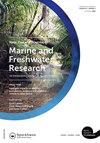历史数据为最近的监测提供了背景,并显示了100年来河口健康状况的下降
IF 1.7
4区 环境科学与生态学
Q3 FISHERIES
New Zealand Journal of Marine and Freshwater Research
Pub Date : 2022-06-08
DOI:10.1080/00288330.2022.2086588
引用次数: 1
摘要
摘要河口是一个复杂的有效管理系统,需要监测强有力的环境指标来评估健康状况并检测变化。新西兰的常规河口监测方案最多只存在了30年,但河口至少100年来一直受到人为压力的严重影响。我们利用沉积物岩心和航空照片的历史信息重建了河口健康指标的长期变化,并将这些信息与最近的监测数据相结合。这项研究的重点是新西兰怀卡托地区的四个河口,但这些发现可能适用于其他地方。沉积物堆积率在大约100年前增加了几个数量级,但红树林在大约50年前才开始迅速扩张,这与农业和城市发展的集约化相吻合,从而导致淡水质量下降。在过去20年中,环境状况监测显示,大多数监测点的底栖生物健康状况有所下降,一些地方的沉积物持续堆积和红树林扩张。这增加了环境管理不足以保障河口健康的证据的分量,并表明了过去100年来这些系统的变化幅度。本文章由计算机程序翻译,如有差异,请以英文原文为准。
Historical data provides context for recent monitoring and demonstrates 100 years of declining estuarine health
ABSTRACT Estuaries are complicated systems to manage effectively, requiring the monitoring of robust environmental indicators to assess health and detect changes. Routine estuarine monitoring programmes in New Zealand have only existed for 30 years at most, but estuaries have been significantly affected by anthropogenic pressures for at least 100 years. We reconstructed long term changes in indicators of estuarine health using historical information from sediment cores and aerial photographs, and combined this information with recent monitoring data. This study is focused on four estuaries in the Waikato region of New Zealand, but the findings are likely applicable elsewhere. Sediment accumulation rates increased by orders of magnitude c. 100 years ago, but mangrove forests only started to rapidly expand c. 50 years ago, which coincided with the intensification of agriculture and urban development, and resultant declines in freshwater quality. Over the past 20 years, state of the environment monitoring shows declines in benthic health at most monitoring sites, as well as continuing sediment accumulation and mangrove expansion in some places. This adds to the weight of evidence that environmental management has not been sufficient to safeguard estuarine health and demonstrates the magnitude of change in these systems over the past 100 years.
求助全文
通过发布文献求助,成功后即可免费获取论文全文。
去求助
来源期刊
CiteScore
4.50
自引率
12.50%
发文量
35
审稿时长
3 months
期刊介绍:
Aims: The diversity of aquatic environments in the southern continents and oceans is of worldwide interest to researchers and resource managers in research institutions, museums, and other centres. The New Zealand Journal of Marine and Freshwater Research plays an important role in disseminating information on observational, experimental, theoretical and numerical research on the marine, estuarine and freshwater environments of the region.

 求助内容:
求助内容: 应助结果提醒方式:
应助结果提醒方式:


